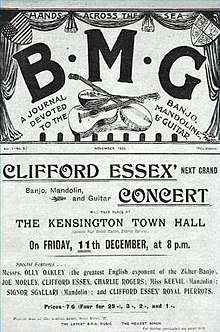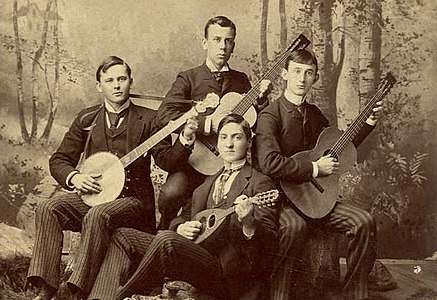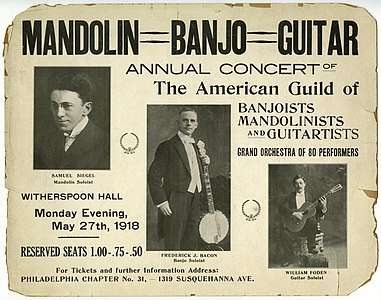BMG movement
The Banjo, Mandolin and Guitar (BMG) movement is a music genre based on the family of fretted stringed instruments played with a plectrum or fingers, with or without fingerpicks. The instruments include the banjo, mandolin and guitar. This became popular in the USA in the late 19th century and into the 20th century.[1] It fell from favour in the 1930s but there is still an organised movement in the UK where the BMG, founded in 1903, is the country's oldest music periodical still publishing. In the United States, a major magazine for the movement was The Cadenza magazine, published by Clarence L. Partee.[2]

The November 1903 of BMG magazine, first published by Clifford Essex in London.
Images
 The Banjo, Mandolin & Guitar Club at Washington & Jefferson College in the 1890s
The Banjo, Mandolin & Guitar Club at Washington & Jefferson College in the 1890s Advertisement for the American Guild of banjoists, mandoliniists and guitarists, 1918. It featured prominent instrumentalists of the movement, mandolinist Samuel Siegel, banjoist Frederick J. Bacon and guitarist William Foden.
Advertisement for the American Guild of banjoists, mandoliniists and guitarists, 1918. It featured prominent instrumentalists of the movement, mandolinist Samuel Siegel, banjoist Frederick J. Bacon and guitarist William Foden.
gollark: After all, the halting problem is unsolvable.
gollark: They're clearly just guessing.
gollark: Potatos doesn't halt, and that's okay. It's not okay to do it for no reason.
gollark: 3. useless
gollark: Space: cheaper when you don't go™
References
Citations
- Noonan 2009, p. 1.
- Loomis 1898, pp. 201–202.
Sources
- Loomis, Clark Merrick (1898). "Clarence L. Partee of Kansas City, Mo". Loomis' Musical and Masonic Journal. C. M. Loomis' Sons. 31 (11).
- Noonan, Jeffrey (2009), "The Banjo, Mandolin and Guitar (BMG) Movement", The Guitar in American Banjo, Mandolin and Guitar Periodicals, 1882-1933, ISBN 9780895796448
This article is issued from Wikipedia. The text is licensed under Creative Commons - Attribution - Sharealike. Additional terms may apply for the media files.